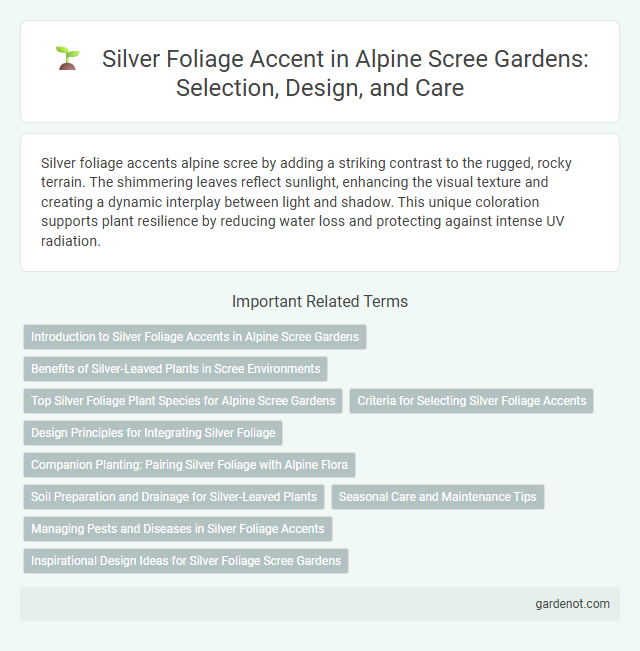Silver foliage accents alpine scree by adding a striking contrast to the rugged, rocky terrain. The shimmering leaves reflect sunlight, enhancing the visual texture and creating a dynamic interplay between light and shadow. This unique coloration supports plant resilience by reducing water loss and protecting against intense UV radiation.
Introduction to Silver Foliage Accents in Alpine Scree Gardens
Silver foliage accents in alpine scree gardens enhance visual contrast and texture, thriving in well-drained, rocky soils characteristic of these environments. Species like Artemisia and Stachys byzantina offer drought tolerance and reflective leaf surfaces that reduce heat stress and conserve moisture. Incorporating silver-leaved plants increases biodiversity and emphasizes the rugged beauty essential to alpine scree ecosystems.
Benefits of Silver-Leaved Plants in Scree Environments
Silver-leaved plants in alpine scree environments enhance drought resistance due to their reflective foliage that reduces water loss and heat stress. Their light-colored leaves improve photosynthetic efficiency under intense sunlight and protect delicate roots from temperature extremes. These adaptations support plant survival and biodiversity in harsh, rocky terrains typically found in scree slopes.
Top Silver Foliage Plant Species for Alpine Scree Gardens
Top silver foliage plant species for alpine scree gardens include Artemisia 'Silver Mound', Senecio serpens, and Saxifraga paniculata, admired for their drought tolerance and reflective leaves that brighten rocky landscapes. These species thrive in well-drained, stony soils typical of alpine scree, providing textural contrast and enhancing garden aesthetics with their unique silvery hues. Their resilience to harsh conditions and minimal care needs make them essential choices for sustainable alpine garden design.
Criteria for Selecting Silver Foliage Accents
Silver foliage accents in alpine scree environments require plant species that demonstrate drought tolerance, reflecting sunlight to reduce water loss and thriving in well-drained, rocky soils. Selection criteria emphasize compact growth habits and resilience to temperature fluctuations, ensuring the foliage maintains its silvery hue under intense UV exposure and alpine climatic stress. Prioritizing native silver-leaved plants like Artemisia and Senecio can enhance both ecological compatibility and visual contrast in scree gardens.
Design Principles for Integrating Silver Foliage
Incorporating silver foliage into alpine scree designs enhances visual contrast with rocky textures, emphasizing natural ruggedness while providing a calming, cool-toned palette. Careful selection of plants like Artemisia and Senecio ensures drought tolerance and texture variation, supporting low-maintenance sustainability. Placement strategies should maximize sunlight exposure and drainage to maintain plant health and highlight silver hues effectively within the harsh alpine environment.
Companion Planting: Pairing Silver Foliage with Alpine Flora
Silver foliage accents enhance alpine scree gardens by providing striking contrast against rugged stone and vibrant alpine blooms such as Saxifrage and Edelweiss. Companion planting with silver-leaved species like Artemisia or Lamb's Ear creates a textured and visually balanced composition that thrives in well-drained, rocky soil. These combinations improve resilience to drought and temperature fluctuations, promoting healthy growth and long-lasting seasonal interest in alpine landscapes.
Soil Preparation and Drainage for Silver-Leaved Plants
Silver-leaved plants thrive best in well-drained, sandy or rocky soils that mimic their natural alpine scree habitat. Proper soil preparation involves incorporating coarse grit or sand to enhance drainage and prevent root rot. Maintaining slightly alkaline to neutral soil pH supports nutrient uptake essential for the vibrant silver foliage.
Seasonal Care and Maintenance Tips
Silver foliage accents on alpine scree thrive with well-drained soil and minimal watering, mimicking their natural arid habitat. Pruning in early spring encourages healthy growth and maintains their vibrant silvery hue. Protect plants from excessive moisture and frost by applying mulch and ensuring proper drainage during winter months.
Managing Pests and Diseases in Silver Foliage Accents
Silver foliage accents in alpine scree gardens require targeted pest and disease management to preserve their distinctive silvery hues and texture. Common pests such as aphids and spider mites can cause discoloration and leaf damage, necessitating regular monitoring and the application of insecticidal soaps or neem oil. Fungal diseases like powdery mildew thrive in wet conditions, so ensuring proper drainage and air circulation around silver-leafed plants is critical to maintaining plant health.
Inspirational Design Ideas for Silver Foliage Scree Gardens
Silver foliage in alpine scree gardens creates a striking contrast against rugged stone textures, enhancing the naturalistic feel while reflecting sunlight for a luminous effect. Plants such as Artemisia and Santolina offer silvery leaves that thrive in well-drained, rocky soils typical of scree environments, promoting drought resistance and low maintenance. Integrating silver foliage accents inspires creative layering and textural variety, transforming alpine scree spaces into visually captivating, low-water landscapes.
Silver foliage accent Infographic

 gardenot.com
gardenot.com